16th Annual Meeting Review
Orlando, Florida • October 11, 2002
David Polaner, MD, FAAP
The Children's Hospital and University
of Colorado School of Medicine
Denver, CO
The 2002 Annual meeting of the Society, chaired by Maurice S. Zwass (University of California, San Francisco), took place on October 11, 2002 in Orlando, FL. The meeting was again divided into major themes, covering both scientific and clinical areas of anesthesia practice.
The morning's two sessions were devoted to an examination of hemostasis and coagulation. In the first, moderated by Dr. Zwass, Marilyn Manco-Johnson (The Children's Hospital, Denver/ University of Colorado) gave an exceptionally clear review of coagulation in infants and children in the perioperative period. She noted that the classical conception of the clotting cascades, in which two parallel pathways converge with the conversion of Factor X to Factor Xa, has given way to an integrated system in which tissue factor initiates the activation of the coagulation system. This "intrinsic pathway" is now thought to be the dominant system, in which tissue factor, exposed when endothelium is damaged, interacts with zymogen and Factor VIIa to convert a small amount of Factor X to Xa. This is amplified through the entire coagulation system response, including platelet activation and the activation of other coagulation factors to induce clotting as an integrated and interacting circuit. Dr. Manco-Johnson discussed the developmental physiology of the coagulation system, and described the alterations in clotting function in neonates. Neonates are particularly prone to disorders of hemostasis, in that they may have more pronounced tissue factor elaboration. A logical approach to testing and therapy of genetic and ascquired disorders of hemostasis and thrombosis in pediatrics was presented.
Michael A. Gropper (University of California, San Francisco) discussed the sepsis syndrome and its interface with systemic inflammatory response and the coagulation system. The systemic response to infection is characterized by the elaboration of inflammatory mediators such as TNFa, IL-1 and IL-6, which can spill over and injure organs not initially involved in the inciting event. Unfortunately, attempts at blocking these cytokines have not proven successful in improving outcome in multiple clinical trials, probably because we are unable to properly modulate the immune response. Dr. Gropper discussed the role that supportive therapies may have in both attenuating and aggravating the sepsis/ systemic inflammatory response syndrome. The use of low tidal volume ventilation, for example ("protective ventilation strategies") may decrease the elaboration of inflammatory mediators by decreasing alveolar stretch and mechanotransductive effects on the lung. The prime reason for his talk, however, was the important role that the coagulation system plays in the sepsis syndrome. Even patients who do not have an overt coagulopathy such as DIC have demonstrable abnormalities in clotting and fibrinolysis, and it is thought that activation of endothelial cells plays an important role in the propagation of the systemic inflammatory response. A recent large clinical trial using activated protein C showed great promise at decreasing mortality in sepsis syndrome without increasing the risk of infection.
In the second session, moderated by Valerie Armstead (Jefferson Medical College, Philadelphia), B. Craig Weldon (University of Florida, Gainesville) discussed red cell transfusion and conservation techniques. He first discussed the infectious and immunologic risks of transfusion therapy, and updated the audience on the relatively recently recognized problem of transfusion related lung injury (TRALI). While the first two problems are perhaps more familiar to most anesthesiologists, TRALI has become an area of increased clinical and laboratory investigation, and might be responsible for as many as 13 percent of transfusion-related deaths. Incited by immunologic factors such as inadvertently transfused white cells and humoral factors, this "innocent bystander" injury to the lungs can result in acute respiratory failure similar to ARDS. Leukocyte reduction or irradiation may reduce the risk. The relative risks of various transfusion-mediated infections were discussed, with current rates from both hepatitis and HIV now below the one per 1 million mark. The transfusion trigger- the hematocrit or hemoglobin concentration at which one decides to transfuse- was discussed next. The concept of critical oxygen delivery was introduced, in which the transfusion trigger is linked to how much oxygen must be delivered to end organs. Data and lessons learned from clinical scenarios of extreme anemia were discussed, although conclusive data in children remain scant. Dr. Weldon also described the risks and benefits of directed donor and autologous donor transfusions. Several blood conservation techniques have been found to be effective in children, including deliberate (controlled) hypotension, acute normovolemic hemodilution, intraoperative blood salvage (Cell Saver), and perioperative recombinant erythropoietin therapy. The relative merits, efficacy, and risks of each, as well as the multimodal use of several strategies in combination, were compared and contrasted.
A fascinating lecture on the search for an effective and safe blood substitute was given by Bruce D. Spiess (Medical College of Virginia). He first reviewed the history of blood substitutes and their clinical trials, from stromal-free hemoglobin and other hemoglobin-based oxygen carriers to oxygen-carrying perfluorocarbon emulsions, and noted the political issues surrounding the development of these agents due to their potential applications in military medicine. In addition to the obvious use of these agents as blood substitutes, Dr. Speiss introduced the audience to the concept of "oxygen therapeutics"- the use of hemoglobin substitutes as oxygen delivery agents to sites that natural blood perfusion might not be able to reach. Perfluorocarbons, for example, could be used to provide oxygenation to regions occluded by stroke or thrombosis, potentially preventing or ameliorating infarction in the emergency setting. Since these agents can carry nitrogen as well, they have application in diving medicine and the treatment of air embolism.
he afternoon session, moderated by Anne M. Lynn (Children's Hospital and Regional Medical Center, Seattle / University of Washington), began with a debate on the use of the laryngeal mask airway for tonsillectomy and adenoidectomy. Elizabeth S. Yun, MD (University of Wisconsin) advocated for the LMA, first describing the technique in this setting, and noted that several small studies have suggested lower rates of coughing and laryngospasm, along with perhaps better airway protection from aspiration than an uncuffed endotracheal tube. She showed photographs to document that the flexible LMA does not obstruct the surgeon's view of the field. Rita Agarwal (The Children's Hospital, Denver / University of Colorado) took the opposing position, arguing that in patients with obstructive sleep apnea (a common indication for tonsillectomy) spontaneous ventilation may be more difficult to achieve, and that an equal number of small studies showed higher rates of airway problems with the LMA. If these occur intraoperatively, it may necessitate changing to an endotracheal tube in the middle of the procedure, when the oropharynx is bloody. Surgical acceptance may be a problem with introducing the use of the LMA as well. Mark Schreiner (Children's Hospital of Philadelphia, University of Pennsylvania, and the Children's Clinical Research Institute) completed the session with a superb lecture on evidence-based medicine, and how critical reading and analysis of the literature can help in clinical decision-making. Using the case of the LMA, he discussed the clinical investigations cited by both debaters, and noted that none of the data in the studies provided conclusive evidence to definitively support either position! Flawed study design and inadequate power were mentioned as the two most common defects that limit the ability to draw conclusions from clinical investigations.
Letty M.P. Liu (Massachusetts General Hospital / Harvard Medical School) moderated the final session of the day. Zeev N. Kain (Yale University School of Medicine) concluded the pediatric anesthesia topics with a survey of issues related to family-centered care in pediatric anesthesia. The majority of scientific data in this field has been generated by Dr. Kain and his research group at Yale, where rigorous methodology has been applied to studying issues that were previously addressed only by descriptive or poorly controlled and validated techniques. He discussed parental presence during induction, pre-medication, postoperative behavioral disturbances, and related topics, and stressed that as pediatric anesthesiologists we can do much to influence the behavioral and psychosocial outcome, as well as the medical outcome, of our patients. He noted that the consequences of these events last far longer than many of us would expect, and also cautioned that before adopting an intervention or program, there should be compelling evidence that it can achieve its objective. This crucial aspect of care, often neglected when considering anesthetic technique, is likely to come under increasing scrutiny and emphasis by both professionals and families.
The final presentation of the meeting was given by Warren M. Zapol (Massachusetts General Hospital / Harvard Medical School). Dr. Zapol, the Reginald Jenny Professor and Chairman of the Department of Anesthesia at the MGH, has had an exciting and unusual research career that has gone far beyond the walls of the Wellman Research Building and Respiratory Intensive Care Unit at the MGH in Boston. He spoke about his fascinating and groundbreaking (or icebreaking??) research on the Weddell seal, the champion diver of the Antarctic. Dr. Zapol has spent seven austral summers on the Ross Ice Shelf and McMurdo Station in Antarctica leading an international team of scientists studying the diving physiology of these seals and learning how they are able to withstand the extremes of hypoxia. He illustrated his talk with stunning photographs, and hinted at the implications of his findings in human conditions of hypoxia during diving.
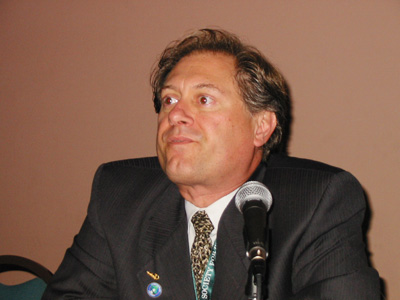
B. Craig Weldon, MD
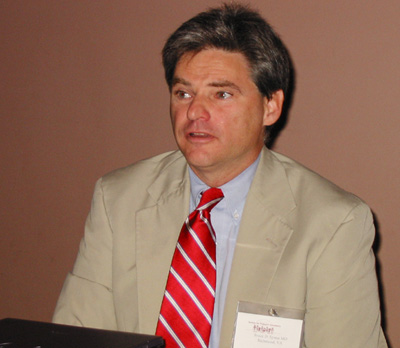
Bruce D. Spiess, MD

Elizabeth S. Yun, MD
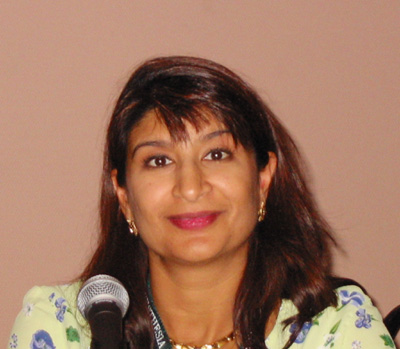
Rita Agarwal, MD
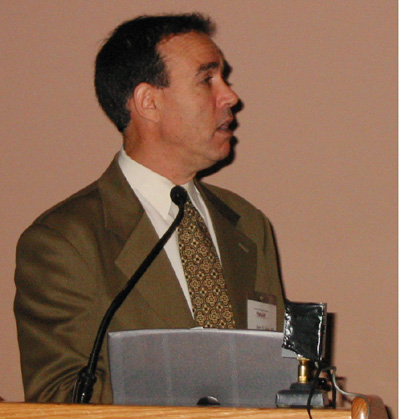
Zeev N. Kain, MD
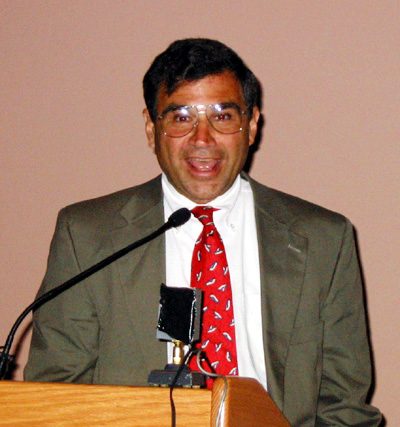
Warren M. Zapol, MD